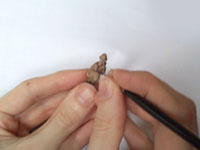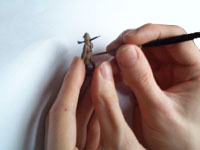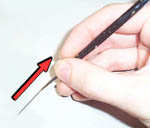If you have just started to paint and the results are rather
depressing, then don't despair. Achieving good results may be easier (or
at least more possible) than you think. In order to paint well, you will
need to master four areas, but having done this there's not much else to
go wrong.
1) Colour Scheme

Use Inspiration
Colour schemes are probably the easiest thing to get right because you
can always copy someone else's. There are plenty of examples on the Internet
and in gaming magazines.
Limit the number of colours
If you decide to make up your own, then try to limit the number of
colours you use. It is a common mistake by inexperienced painters to use
lots of bright colours, and unless these are chosen skilfully can result
in a crude and discordant effect. An artist, whose name escapes me, once
said of paintings 'Use only three colours and then, if you need to, add
a fourth'. More or less the same holds true for figures. Limit yourself
to a few saturated colours and for the rest of the figure use more neutral
colours such as greys, browns, white or black.
2) Mixing Colour Shades

Shading Accentuates the Form
Figures look better shaded than painted with flat colours. The shading
helps to enhance the shape of the figures and to bring out the detail,
as well as creating effects such as weathered metal.
Simple and Complicated Colours for Shading
To shade in a natural manner you will need an understanding of how colours
can be mixed to create light and dark shades of the same colour. Some,
such as any grey, are easy because you simply add black or white to the
base colour. Others, such as yellow are more complex. This is because
adding black or white, as well as altering the brightness of a colour,
will also reduce the saturation
and in some cases will even alter the hue.
In order to make the shading look natural you will need to add other
colours to the shading mix to compensate. In the case of yellow, when
it is mixed with black it will become green. To prevent this red should
be added as well as the black. This will result in a chestnut brown which
looks more appropriate.
(I am currently working on a more detailed description
of this process).
3) Consistency

Keep it wet
The consistency of the paint, that is how dilute or dry it is also an
important area. In most situations it will be necessary to dilute the
paint before putting it onto the figure.Neat acrylic is usually quite
viscous, which makes it difficult to apply precisely because it will make
the tip of the brush slightly tacky. This is particularly important when
painting fine lines. If the paint is too dry then it will tend to result
in lumpy and uneven brushstrokes instead of a smooth thin line of constant
thickness.
Before applying paint to the brush, dip the head in water. Each time
you get more paint from the pots to put on the palette, dip the brush
tip in clean water and mix this into the paint. This will also prevent
the paint from drying too quickly. If the paint is too dilute then it
will stop covering properly, and will start to run across the surface
of the figure to places you don't want it to. Whilst this is desirable
when applying a wash, normally you should aim to dilute the paint as much
as possible without this occurring.
4) Accurate brushwork

Painting Position
Getting the paint in the right place does not require as much hand-eye
co-ordination as many people think. If you can thread a needle and write
legibly with a pen then you can paint a perfectly good figure. However,
it is important to use the right stance when painting. Don't put the figure
down on the surface of a table when painting it, but instead hold it so
that it can be constantly repositioned. The hand holding the figure should
always be touching the hand holding the brush, even if it is just the
tips of the little fingers which are in contact. This will help to prevent
one hand moving in relation to the other.


|
Brush Orientation
It is also important to orientate the figure appropriately. When
holding a brush it is easier to move it accurately in some directions
than others. The exact angle depends on how you hold the brush,
but it will usually be a diagonal as shown on the right.
When painting fine lines for shading or patterning you should orientate
the figure so that this line coincides with your 'natural angle'
to make it as easy as possible.
|

|
Brush Quality
Finally to apply paint accurately you will need a quality brush in good
condition, as described in this guide to brushes.





